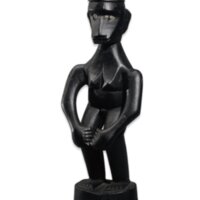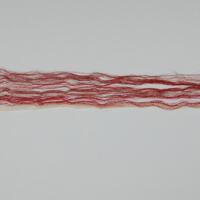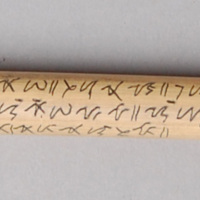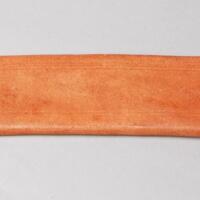Drawing
Text
Preparatory drawing (hanshita-e) for an illustrated book, mounted on card. (R-L) Men from Vietnam, Philippines and Ryukyu. Ink on paper. 1820s-1840s Inscription:Inscription type: inscription Inscription language: Japanese Inscription quoted: 東京也・安南・交趾・交州・並同 呂宋・コソン・ルソン・並同・唐音也 琉球・名中山國 Inscription transliteration: Tonkin nari, Annan, Kōchi, Kōshū, narabi ni onaji Ryosō, Koson, Ruson, narabi ni onaji, tōon nari Ryūkyū, na [o] Chūzankoku Inscription translation: Vietnam Phillipines Ryūkyū
Curators comments:
This group of 103 drawings represents a major new discovery relating to Hokusai’s life and works. An amazing range of subjects is represented – figure (religious, mythological, historical, literary), animal, bird and flower and other natural phenomena, and landscape. As the subtitle ‘India, China’ signals, the group is dominated by subjects that relate to China, Southeast Asia, India and lands further west. Some of the same subjects can be found within Hokusai’s known oeuvre, but many are completely new discoveries. Among the latter is a fascinating group of images which imagine the origins of human culture in ancient China – early forms of habitation, fire, agriculture, making rice wine and paper, among other scenes. All are treated with the customary fantasy, invention and brush skill found in Hokusai’s late works that could not be matched by any of his pupils – with the possible exception of his artist-daughter Eijo (art-name Ōi, about 1800-after 1857). Hokusai lived and worked with Eijo from around 1830 until his death in 1849, as presented in the British Museum exhibition Hokusai: Beyond the Great Wave in 2017. The current numbering of the 103 drawings, written in pencil on the verso, appears to be random. It will be fascinating, as study of the drawings progresses, to propose groupings of related subjects and demonstrate how these relate to the wider Hokusai oeuvre. The group of drawings apparently has a secure date (9th month, 1829) and can be related stylistically to a group of 178 pages of similar block-ready drawings in the Museum of Fine Arts, Boston (1998.670.1-3). The Boston drawings are bound together into the three-volume format in which it was intended that should be published (Thompson 2016)*. As with the present group, however, publication did not take place for some reason and so the block-ready drawings were not destroyed in the process of cutting the cherry-wood printing blocks. Such survivals are rare and in the case of Hokusai, they are a phenomenon of his later career, from his sixties onwards. A handful of the drawings here can also be related to working sketches by Hokusai in an album in the Bibliothèque nationale, Paris (the so-called ‘Curtis’ album, Dd 3251 res). Integrated study of these three major groups of Hokusai’s drawings will revolutionise our understanding of his working method and artistic ambition. The discovery of the drawings is additionally significant as it helps to fill in a hitherto relatively empty period in his career, the late 1820s. This was a time when Hokusai suffered a series of difficult personal challenges, including a stroke in 1827 or 1828, from which he recovered; the death of his second wife in 1828; and near destitution, as pleaded in a letter of the first month, 1830. This may have been the time when Hokusai’s daughter Eijo, herself a successful artist, came back to live and work with her father, following her divorce. Two seals are included in the preface: ‘Yoshinoyama’ and Mt Fuji above trigram. Further work is required to authenticate these seals, both of which seem to be rare. The Yoshinoyama seal appears to be a hand-impressed version of the same seal that is printed in the colophon to the illustrated book Hokusai gashiki (1819, BM 1915,0823,0.88). The Mt Fuji above trigram appears to be a hand-impressed version of the same seal that is printed in the colophon of Ehon sakigake, vol. 1 (1836, BM 1979,0305,0.455). The idiosyncratic style of calligraphy of the handwritten preface is identical to the printed preface of Chūgi Suikoden ehon (1829, BM 1979,0305,0.435). (T. Clark, Jul 2020) * Sarah Thompson, Hokusai’s Lost Manga, Boston, Museum of Fine Arts, 2016. (A Japanese translation, Hokusai manga, nikuhitsu mikankō ban 北斎漫画、肉筆未刊行版, was published in 2017 by Kawade Shobō Shinsha, Tokyo.)
Department: Asia
Share this



